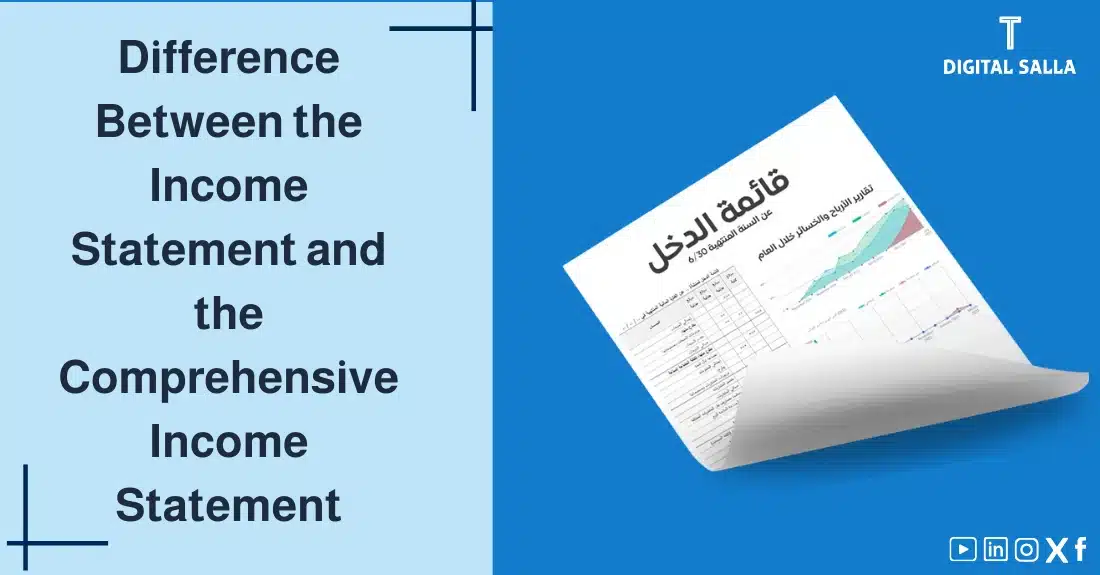Difference Between Income Statement and Statement of Comprehensive Income Statement

Both the Income Statement and the Statement of Comprehensive Income are among the most important Financial Statements that provide essential information about an entity’s performance and profitability over a specific period. Although they are closely related, the Difference Between Income Statement and Statement of Comprehensive Income lies in their scope and the information they present. In this article, we will discuss the Difference Between Income Statement and Statement of Comprehensive Income, clarify the components of each, how they are prepared, and emphasize the importance of each statement to users of the financial statements in assessing the company’s performance.
What is the Income Statement?
The Income Statement, also known as the Profit and Loss Statement, is one of the basic Financial Statements that shows an entity’s revenues, expenses, and net profit or loss during a specific period (usually quarterly or annually). The Income Statement provides a summary of the results of the entity’s operating activities during that period and helps in assessing its efficiency and profitability.
What is the Statement of Other Comprehensive Income?
The Statement of Other Comprehensive Income is a Financial Statement that shows changes in equity that do not result from transactions with owners (such as dividends) and are not recognized in the Income Statement. Items of other comprehensive income include items such as:
- Foreign currency translation differences (from translating the financial statements of foreign subsidiaries).
- Fair value gains or losses on certain available-for-sale financial instruments.
- Gains or losses on revaluation of fixed assets (if the revaluation model is followed).
- Part of the gains and losses on hedging instruments in a cash flow hedge (the part considered an effective hedge).
- Changes in the revaluation surplus of assets according to IAS 16.
- Changes in the fair value of equity investments according to IFRS 9 (if the entity elects to do so).
- The Expected Credit Loss under IFRS 9
The Difference Between Income Statement and Statement of Comprehensive Income:
The Difference Between Income Statement and Statement of Comprehensive Income is that the Income Statement only shows revenues and expenses recognized during the period, which affect net profit or loss. While the Statement of Other Comprehensive Income shows changes in equity that are not recognized in the Income Statement, meaning it includes items that do not affect net profit or loss but do affect total comprehensive income. Understanding the Difference Between Income Statement and Statement of Comprehensive Income is essential for accurate financial analysis.
In other words, the Difference Between Income Statement and Statement of Comprehensive Income is as follows:
- The Income Statement focuses on measuring the Financial performance of the entity from ordinary activities.
- The Statement of Other Comprehensive Income focuses on measuring all changes in equity except those resulting from transactions with owners.
Components of the Income Statement:
The Income Statement consists of the following key elements:
- Revenues: Inflows of economic benefits during the financial period, arising from the ordinary activities of the entity.
- Cost of Goods Sold (COGS): The direct costs of the goods that were sold during the financial period.
- Gross Profit: The difference between sales revenue and the cost of goods sold.
- Operating Expenses: Expenses incurred by the entity to carry out its ordinary activities, other than the cost of goods sold.
- Operating Profit: The profit resulting from the entity’s ordinary operating activities.
- Other Income and Expenses: Revenues and expenses that are not related to the entity’s ordinary operating activities.
- Profit or Loss Before Tax: Profit or loss before deducting income tax.
- Income Tax Expense: The amount of tax payable on the entity’s profits during the financial period.
- Net Profit or Loss: The entity’s final profit or loss after deducting all expenses, including income tax.
Components of the Statement of Other Comprehensive Income:
The Statement of Other Comprehensive Income includes the following items:
- Foreign currency translation differences: Changes in the value of assets and liabilities resulting from translating the financial statements of foreign subsidiaries into the presentation currency.
- Fair value gains or losses on certain available-for-sale financial instruments: Changes in the fair value of financial instruments classified as available-for-sale that are not recognized in the Income Statement.
- Gains or losses on revaluation of fixed assets: Changes in the fair value of fixed assets when using the revaluation model according to IAS 16.
- Part of the gains and losses on hedging instruments in a cash flow hedge (the part considered an effective hedge).
- Changes in the revaluation surplus of assets according to IAS 16.
- Changes in the fair value of equity investments according to IFRS 9 (if the entity elects to do so).
- The Expected Credit Loss according to IFRS 9.
Methods of Presenting the Statement of Comprehensive Income:
The Statement of Comprehensive Income can be presented in one of two ways:
- Single statement: Items of the Income Statement and items of other comprehensive income are presented in one continuous statement, starting with net profit or loss from the Income Statement, then adding or subtracting items of other comprehensive income to arrive at total comprehensive income.
- Two separate statements: The Income Statement is presented separately, followed by the Statement of Other Comprehensive Income, which begins with net profit or loss from the Income Statement, then adds or subtracts items of other comprehensive income to arrive at total comprehensive income.
Importance of the Income Statement and the Statement of Other Comprehensive Income:
- Assessing financial performance: The Income Statement helps assess the entity’s profitability and the efficiency of its operating activities, while the Statement of Other Comprehensive Income provides a broader view of changes in equity.
- Decision-making: Both the Income Statement and the Statement of Other Comprehensive Income provide essential information for making investment, financing, and management decisions by various stakeholders.
- Forecasting future performance: Information from the Income Statement and the Statement of Other Comprehensive Income, along with information from other Financial Statements, can be used to forecast the entity’s future performance.
- Understanding the nature of profits and losses: The Statement of Other Comprehensive Income helps understand the nature of profits and losses that are not recognized in the Income Statement, such as foreign currency translation differences.
- Evaluating earnings quality: The Statement of Other Comprehensive Income can help assess the quality of earnings reported in the Income Statement by analyzing items of other comprehensive income that may affect future earnings.
Example of an Income Statement and a Statement of Other Comprehensive Income and Explaining the Difference Between Income Statement and Statement of Comprehensive Income:
Company “A” Income Statement for the Year Ended December 31, 2023
| Statement Item | Amount (Riyals) |
|---|---|
| Sales Revenue | 500,000 |
| Cost of Goods Sold | (200,000) |
| Gross Profit | 300,000 |
| Operating Expenses | (100,000) |
| Operating Profit | 200,000 |
| Other Income | 10,000 |
| Other Expenses | (5,000) |
| Profit Before Tax | 205,000 |
| Income Tax Expense | (50,000) |
| Net Profit | 155,000 |
Company “A” Statement of Other Comprehensive Income for the Year Ended December 31, 2023
| Statement Item | Amount (Riyals) |
|---|---|
| Net Profit | 155,000 |
| Items of Other Comprehensive Income: | |
| Foreign Currency Translation Differences | 15,000 |
| Fair Value Gains on Available-for-Sale Securities | 5,000 |
| Total Items of Other Comprehensive Income | 20,000 |
| Total Comprehensive Income | 175,000 |
Note: This is a simplified example and is intended to illustrate the main idea. The items in the Income Statement and the Statement of Other Comprehensive Income may vary from one company to another.
Role of Technology in Preparing the Income Statement and the Statement of Other Comprehensive Income:
Accounting software and Enterprise Resource Planning (ERP) systems help automate the process of preparing the Income Statement and the Statement of Other Comprehensive Income, leading to:
- Increased speed and efficiency of preparing financial statements.
- Reduced human errors in recording and posting entries.
- Improved accuracy of financial data.
- Saving time and effort.
- Generating various financial reports and advanced financial analyses.
The Relationship Between the Income Statement, the Statement of Other Comprehensive Income, and International Standards:
Both the Income Statement and the Statement of Other Comprehensive Income are closely related to International Financial Reporting Standards (IFRS). For example:
- IAS 1 “Presentation of Financial Statements”: This standard sets out the requirements for presenting the Income Statement and the Statement of Other Comprehensive Income, including the minimum items that must be presented in each statement.
- IFRS 15 “Revenue from Contracts with Customers”: This standard specifies how to recognize and measure revenue, which directly affects the Income Statement.
- IFRS 9 “Financial Instruments”: This standard specifies how to classify and measure financial instruments, and affects how some items of other comprehensive income are recognized, such as fair value gains or losses on certain financial instruments.
Conclusion:
The Income Statement and the Statement of Other Comprehensive Income are two of the most important financial statements that provide essential information about an entity’s performance and profitability over a specific period. IAS 1 provides a clear framework for presenting these two statements, while other IFRSs specify how to recognize and measure items of revenues, expenses, and other comprehensive income.
Understanding the Difference Between Income Statement and Statement of Comprehensive Income, their components, how to prepare them, and their analyses is essential for all stakeholders, including investors, creditors, and management. Mastering the skills of analyzing these statements enhances your ability to evaluate the entity’s performance and make informed economic decisions. Finally, technological advancements facilitate the preparation of these two statements and improve the quality and accuracy of the financial information provided, enhancing the effectiveness of these statements as tools for assessing the entity’s performance
